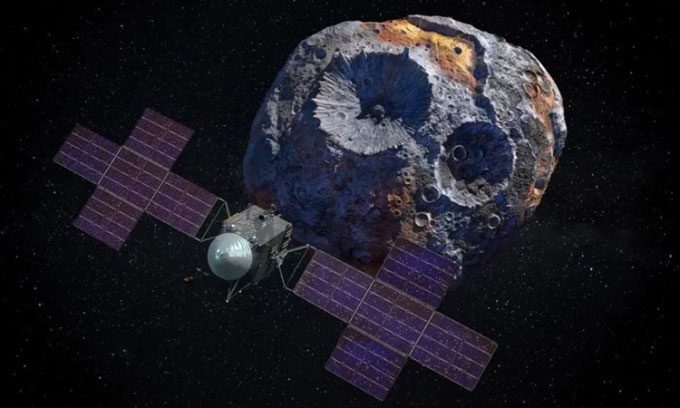The laser data transmission system aboard the Psyche spacecraft is currently en route to the asteroid belt between Mars and Jupiter, transmitting data to Earth at a record distance.
Located on NASA’s Psyche spacecraft, the deep space optical communication technology continues to break records. While the spacecraft does not rely on optical communication for data transmission, this new technology demonstrates the ability to accomplish this task. After connecting to Psyche’s radio frequency transmitter, the laser communication system sent a copy of technical data across a distance of 225 million kilometers, which is 1.5 times the distance between Earth and the Sun, as reported by Phys.org on April 25.

Simulation of the Psyche spacecraft flying to the asteroid of the same name. (Photo: Forbes).
This achievement shows that the spacecraft can utilize optical communication in the future, enabling the transmission of complex scientific information as well as high-resolution images and videos at faster speeds to support humanity’s next significant step of sending people to Mars.
The laser communication technology in this experiment is designed to transmit data from deep space at speeds 10 to 100 times faster than modern radio frequency systems currently used in missions. After its launch on October 13, 2023, the spacecraft continues to operate well and steadily on its journey to the main asteroid belt between Mars and Jupiter to visit the Psyche asteroid. NASA’s optical communication experiment demonstrated that the system can transmit test data at a maximum speed of 267 megabits per second (Mbps) from a near-infrared laser source in the laser transceiver while in flight.
Previously, on December 11, 2023, the experiment transmitted a 15-second ultra-high-definition video to Earth from a distance of 31 million kilometers, approximately 80 times the distance between Earth and the Moon. Along with many other test data, the video included a digital version of the Psyche Inspired painting from the University of Arizona, uploaded to the laser transceiver during flight before the Psyche spacecraft was launched last year. Now, as the spacecraft is flying at a distance seven times greater, the speed of data transmission and reception has decreased as expected. In an experiment on April 8, the spacecraft transmitted test data at a maximum speed of 25 Mbps, far exceeding the project’s goal of at least 1 Mbps at that distance.
The project team also sent commands to the transceiver to transmit data generated by Psyche using optical technology. Although Psyche transmits data via the radio frequency channel to NASA’s Deep Space Network (DSN), the optical communication system simultaneously transmits a portion of that data to the Hale Telescope at the Palomar Observatory of the California Institute of Technology (Caltech) in San Diego County, California.
After the Psyche spacecraft was launched, the initial optical communication test system was used to upload pre-loaded data, including a video featuring a cat named Taters. Subsequently, the project demonstrated that the transceiver could receive data from a high-power laser at the Table Mountain facility of the Jet Propulsion Laboratory (JPL) near Wrightwood, California. The data could even be transmitted to the receiver, then sent back to Earth that same night.
The experiment transmitted test data as well as digital images to the Psyche spacecraft and back to Earth over a round trip of 450 million kilometers. It also uploaded a large amount of technical data from the test version to study the characteristics of the optical communication link.




















































